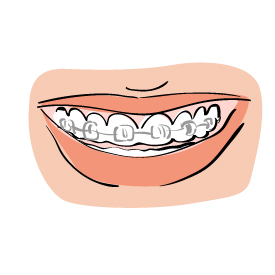
Orthodontics and pedodontics
A few details about these two subjects:
Orthodontics refers to straightening teeth and additionally preventing and correct certain changes occurring in any component of the dento-maxilary system. Malocclusions appear as an expression of genetic inheritance, but also due to factors in the external environment, bad habits (thumb sucking, long bottle-feeding, pacifier use, oral respiration etc.) that directly affect the growth and development of the dento-maxilary system.
For the earliest possible detection and correction of dental abnormalities it is recommended a dental check since the period of milk teeth (Deciduous/primary teeth). Around the age of 6, when the first permanent teeth (molars 6 years, erupting behind milk teeth) a visit to the orthodontist is required. Depending on the abnormality and its time of diagnosis, decisions can be made regarding braces or other type of useful device for quick correction.
It is never too late to decide to have a beautiful and healthy smile. Teeth may corrected at any age!
Why is orthodontic treatment necessary?
Malpositions and dental crowding correction, in addition to aesthetic benefits, ensure a healthy maxillary. Misaligned teeth are harder to clean, often have cavities, tartar and gum diseases. A poor mastication is manifested by muscle fatigue, pain and, in time, it has repercussions on teeth and temporomandibular joint. Depending on the type of anomaly present and the patient’s age, orthodontic treatment can vary from several months to several years.
When should look for signs of malocclusion (poor bite)?
It is very important to review your children’s teething. Although each child has a different growth rate, there is an average age of eruption for each group of deciduous teeth (milk teeth) and permanent teeth.
Several signs may indicate the need for an immediate orthodontic control:
- Early loss of a temporary (milk) tooth
- Difficulty in chewing
- Crowded teeth, crooked, blocked (not shown on the arcade after the age of eruption)
- Grinding in the temporomandibular joint
- Frequent cheek biting
- Teeth that do not meet (space remains between them)
- Jaws that are not proportional with the rest of the face
- Thumb sucking or other bad habits
- Upper teeth that are out or spaced
- Front upper teeth growing behind the lower
- Upper teeth covering more than 40% the lower teeth when biting
- Pointed or receding chin
- The line in the center of the upper and lower teeth is not aligned when biting
- Excessive spaces between teeth that remains after the appearance of permanent canines.
What are the benefits of early treatment (on time)?
- Guiding jaw growth, thus creating a favorable environment for the eruption of permanent teeth
- Guiding permanent teeth into proper position
- Adjusts the size of the dental arcades
- Decreases the risk of injury of prominent front teeth
- Corrects vicious habits at an early stage
- Reduces the risk of blocking or crooked eruption of permanent teeth
- Maintains or gains space for erupting teeth
- Allow easier correction.
There are two types of orthodontic appliances: fixed and mobile. The fixed devices consist of brackets applied to each tooth and a succession of arches ensures the alignment of teeth and resolve the abnormalities. These brackets can be made in metal or ceramic. Mobile devices are especially suitable for children until the completion of the replacement process for baby teeth with permanent ones. These mobile devices have the disadvantage that treatment success depends on the willingness of the child to wear the device.
Ceramic braces are an alternative for those who do not want the device to be so visible. Like metal braces, ceramic braces are very comfortable and very effective in aligning teeth.
Ceramic brackets are made of transparent material, so that the visibility of the tooth becomes much smaller. Due to the fact that braces are less visible, more attention to oral hygiene is needed.
Regular control
Each braces require regular control at a certain time determined by the doctor for follow-up treatment and device activation.
Retainer (orthodontic device)
At the end of orthodontic treatment, to stabilize the result and prevent relapse, wearing a restraining device (like a mobile device overnight) is recommended. This restraining device can sometimes be fixed to the internal side of the tooth, which means it is not visible.
At Estedent Dental Clinic, consultation is FREE. To choose braces according to the situation and your budget, make an appointment here. We’ll help you understand why you need to straighten your teeth and will present options specific to your situation.
